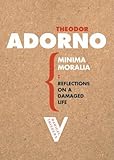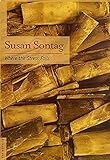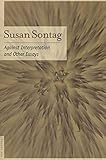For me, 2012 has been at least as much a Year in Not Reading as a Year in Reading. Like a lot of members of the book-based community, I’m prone to making aspirational purchases, as though buying a book were somehow the first link in an unbroken chain of causation that ends, inevitably, with having read it. For me, it’s become increasingly clear that this is a form of magical thinking, but there’s no sign of my changing my ways just because I’ve had this realization. I’m always buying books on the basis that they are exactly the books I should be reading, while knowing that the likelihood of my ever starting them, let alone finishing them, is vanishingly small. I am, as we say in Ireland, a divil for it. I have no idea how many works of academic literary criticism I have bought on this basis, but it is, I fear, a number approaching shitloads.
 There’s one book in particular that I have spent much of this year not reading, and that’s Adorno: A Biography by Stefan Müller-Doohm. I’m pretty sure that my relationship with this book is a lot more intimate and emotionally fraught than it would be if I’d actually read it. For the past nine months or so it has been squatting on my desk, in all its arrogant bulk and imperious disdain — like Ray Winstone in scholarly-volume form — taunting me with the fact of my not having read it. The thing about Adorno: A Biography is that it couldn’t care less that I haven’t read it; in fact, it seems to derive a kind of smug enjoyment from my continuing failure to do so. It knows all about the life and writings of Theodor Adorno, and will continue knowing all about them regardless of whether I read it. It also knows me better than I know myself, this book; it knows that I’m the type of person who will buy a 648-page biography of Theodor Adorno, but not, crucially, the type of person who will read it.
There’s one book in particular that I have spent much of this year not reading, and that’s Adorno: A Biography by Stefan Müller-Doohm. I’m pretty sure that my relationship with this book is a lot more intimate and emotionally fraught than it would be if I’d actually read it. For the past nine months or so it has been squatting on my desk, in all its arrogant bulk and imperious disdain — like Ray Winstone in scholarly-volume form — taunting me with the fact of my not having read it. The thing about Adorno: A Biography is that it couldn’t care less that I haven’t read it; in fact, it seems to derive a kind of smug enjoyment from my continuing failure to do so. It knows all about the life and writings of Theodor Adorno, and will continue knowing all about them regardless of whether I read it. It also knows me better than I know myself, this book; it knows that I’m the type of person who will buy a 648-page biography of Theodor Adorno, but not, crucially, the type of person who will read it.
 I allowed that domineering bastard into my life in the first place after reading — as opposed to merely purchasing — Adorno’s Minima Moralia: Reflections from Damaged Life (which, ironically, I wrote about here in the context of its bucking the trend of my failures of readerly steadfastness). It’s an amazing book of short essays and elegant aphorisms on a vast array of topics — love, capitalism, war, fascism, children’s toys, architecture, psychoanalysis — that contains some of the most beautiful accumulations of sentences I’ve ever come across. Like this, for instance:
I allowed that domineering bastard into my life in the first place after reading — as opposed to merely purchasing — Adorno’s Minima Moralia: Reflections from Damaged Life (which, ironically, I wrote about here in the context of its bucking the trend of my failures of readerly steadfastness). It’s an amazing book of short essays and elegant aphorisms on a vast array of topics — love, capitalism, war, fascism, children’s toys, architecture, psychoanalysis — that contains some of the most beautiful accumulations of sentences I’ve ever come across. Like this, for instance:
Waking in the middle of a dream, even the worst, one feels disappointed, cheated of the best in life. But pleasant, fulfilled dreams are actually as rare, to use Schubert’s words, as happy music. Even the loveliest dream bears like a blemish its difference from reality, the awareness that what it grants is mere illusion. This is why precisely the loveliest dreams are as if blighted.

 I also sat down and properly read a couple of books by Susan Sontag — Against Interpretation and Where the Stress Falls — and loved more or less every word of both, especially the stuff I vehemently disagreed with. I also dipped in and out of the first volume of her journals. As with so many of the best cultural commentators, Sontag’s critical persona was itself a kind of ongoing work of art. I love the spectacle of her hawkish aestheticism; for its own sake, certainly, but also for the way it forced me to think more clearly about my own cultural values. (Right now, I couldn’t tell you exactly what these are, but I do remember having a sense of them at the time).
I also sat down and properly read a couple of books by Susan Sontag — Against Interpretation and Where the Stress Falls — and loved more or less every word of both, especially the stuff I vehemently disagreed with. I also dipped in and out of the first volume of her journals. As with so many of the best cultural commentators, Sontag’s critical persona was itself a kind of ongoing work of art. I love the spectacle of her hawkish aestheticism; for its own sake, certainly, but also for the way it forced me to think more clearly about my own cultural values. (Right now, I couldn’t tell you exactly what these are, but I do remember having a sense of them at the time).
 The most fun I had with a book all year was definitely the Sunday I spent reading David Rees’s How to Sharpen Pencils: A Practical and Theoretical Treatise on the Artisanal Craft of Pencil Sharpening, for Writers, Artists, Contractors, Flange Turners, Anglesmiths, and Civil Servants, with Illustrations Showing Current Practice. (With a title like that, it’s basically immoral to shorten it to its first four words.) It’s a deeply funny and fascinating exercise in sustaining a rarified tone in the face of an apparently absurd subject matter, and it’s also a covert quasi-memoir about obsession and coming to terms with difficulties and disappointment in life and art. Primarily, though, it’s a very, very detailed guide to sharpening the bejesus out of a pencil, and it’s stood me in good stead in that regard. The second most fun I had with a book all year was the second time I read it, about three weeks later.
The most fun I had with a book all year was definitely the Sunday I spent reading David Rees’s How to Sharpen Pencils: A Practical and Theoretical Treatise on the Artisanal Craft of Pencil Sharpening, for Writers, Artists, Contractors, Flange Turners, Anglesmiths, and Civil Servants, with Illustrations Showing Current Practice. (With a title like that, it’s basically immoral to shorten it to its first four words.) It’s a deeply funny and fascinating exercise in sustaining a rarified tone in the face of an apparently absurd subject matter, and it’s also a covert quasi-memoir about obsession and coming to terms with difficulties and disappointment in life and art. Primarily, though, it’s a very, very detailed guide to sharpening the bejesus out of a pencil, and it’s stood me in good stead in that regard. The second most fun I had with a book all year was the second time I read it, about three weeks later.
 As for fiction, I spent quite a lot of time this year harassing friends, acquaintances and perfect strangers to read the Portuguese writer Gonçalo M. Tavares, who I feel confident is lurking somewhere in the general vicinity of genius. I read his “Kingdom” series of novels — Jerusalem, Learning to Pray in the Age of Technique, and Joseph Walser’s Machine — straight through, one after the other, and the experience was a full-on revelation. He’s one of those writers (like, say, Kafka or Beckett) who makes almost all other writers seem not fully serious, as if they are, on some crucial level, just messing about. Not everyone I bullied into reading him was as impressed as I told them they would be; a couple of people said they found his fictional world too cold and inhuman, but this is, I think, exactly what so enthralls me about him. In the best possible way, he writes like an alien.
As for fiction, I spent quite a lot of time this year harassing friends, acquaintances and perfect strangers to read the Portuguese writer Gonçalo M. Tavares, who I feel confident is lurking somewhere in the general vicinity of genius. I read his “Kingdom” series of novels — Jerusalem, Learning to Pray in the Age of Technique, and Joseph Walser’s Machine — straight through, one after the other, and the experience was a full-on revelation. He’s one of those writers (like, say, Kafka or Beckett) who makes almost all other writers seem not fully serious, as if they are, on some crucial level, just messing about. Not everyone I bullied into reading him was as impressed as I told them they would be; a couple of people said they found his fictional world too cold and inhuman, but this is, I think, exactly what so enthralls me about him. In the best possible way, he writes like an alien.
 Chris Ware’s Building Stories was also a rich and remarkable experience. I don’t really know what else to say about it, except that it’s definitely a masterpiece.
Chris Ware’s Building Stories was also a rich and remarkable experience. I don’t really know what else to say about it, except that it’s definitely a masterpiece.
More from A Year in Reading 2012
Don’t miss: A Year in Reading 2011, 2010, 2009, 2008, 2007, 2006, 2005
The good stuff: The Millions’ Notable articles
The motherlode: The Millions’ Books and Reviews
Like what you see? Learn about 5 insanely easy ways to Support The Millions, and follow The Millions on Twitter, Facebook, Tumblr.









